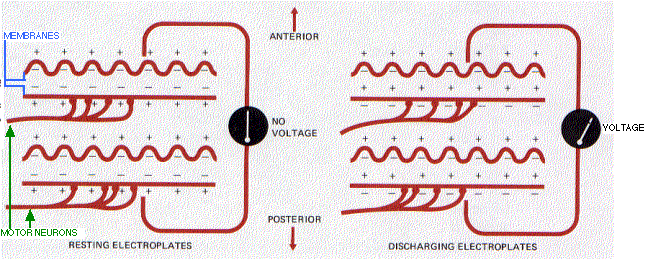Electric organs are masses of flattened cells, called electroplates, which are stacked in regular rows along the sides of certain fishes, e.g., the electric eel of South America.
The posterior surface of each electroplate is supplied with a motor neuron; the anterior surface is not.

At rest, the interior of each electroplate, like a nerve or muscle cell [Link], is negatively charged with respect to the two exterior surfaces. The potential is about 0.08 volt, but because the charges alternate, no current flows.
When a nerve impulse reaches the posterior surface, the inflow of sodium ions momentarily reverses the charge just as it does in the action potential of nerves and muscles. (In most fishes, electroplates are, in fact, modified muscle cells.)
Although the posterior surface is now negative, the anterior surface remains positive. The charges now reinforce each other and a current flows just as it does through an electric battery with the cells wired in "series".
With its several thousand electroplates, the South American electric eel produces voltages as high as 650 volts. The flow (amperage) of the current is sufficient (0.25 - 0.5 ampere) to stun, if not kill, a human. The pulse of current can be repeated several hundred times each second.
Powerful electric organs like those of the electric eel are used as weapons - to stun prey as well as potential predators.The electric organs of many fishes are too weak to be weapons. Instead they are used as signaling devices.
Many fishes emit a continuous train of electric signals in order to detect objects in the water around them. The system operates something like an underwater radar and requires that the fishes also have electroreceptors (which are located in the skin). The presence of objects in the water distorts the electric fields created by the fish, and this alteration is detected by the electroreceptors.Electric fishes use their system of transmitter and receiver for such functions as
 Electroreceptors are also found in some nonelectric fishes and in some amphibians. Even the duckbill platypus, a mammal, has electroreceptors (located in its bill). With these it can detect the weak currents created by the muscle activity of its prey (e.g., small crustaceans) as it noses around in the muddy bottom where it feeds. (Photo courtesy of Australian Information Service.)
Electroreceptors are also found in some nonelectric fishes and in some amphibians. Even the duckbill platypus, a mammal, has electroreceptors (located in its bill). With these it can detect the weak currents created by the muscle activity of its prey (e.g., small crustaceans) as it noses around in the muddy bottom where it feeds. (Photo courtesy of Australian Information Service.)
| Welcome&Next Search |